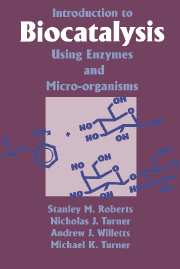Book contents
- Frontmatter
- Contents
- Preface
- Abbreviations
- 1 An historical introduction to biocatalysis using enzymes and micro-organisms
- 2 The interrelationships between enzymes and cells, with particular reference to whole-cell biotransformations using bacteria and fungi
- 3 Useful intermediates and end-products obtained from whole-cell/enzyme-catalysed hydrolysis and esterification reactions
- 4 Useful intermediates and end-products obtained from biocatalysed oxidation and reduction reactions
- 5 Useful intermediates and end-products obtained from biocatalysed carbon–carbon, carbon–oxygen, carbonnitrogen and carbon–chalcogen bond-forming reactions
- 6 The application of biocatalysis to the manufacture of fine chemicals
- Index
2 - The interrelationships between enzymes and cells, with particular reference to whole-cell biotransformations using bacteria and fungi
Published online by Cambridge University Press: 04 August 2010
- Frontmatter
- Contents
- Preface
- Abbreviations
- 1 An historical introduction to biocatalysis using enzymes and micro-organisms
- 2 The interrelationships between enzymes and cells, with particular reference to whole-cell biotransformations using bacteria and fungi
- 3 Useful intermediates and end-products obtained from whole-cell/enzyme-catalysed hydrolysis and esterification reactions
- 4 Useful intermediates and end-products obtained from biocatalysed oxidation and reduction reactions
- 5 Useful intermediates and end-products obtained from biocatalysed carbon–carbon, carbon–oxygen, carbonnitrogen and carbon–chalcogen bond-forming reactions
- 6 The application of biocatalysis to the manufacture of fine chemicals
- Index
Summary
Introduction
There are basically two strategies for carrying out biotransformations: (1) to use pure or partially purified enzymes isolated by the investigator or purchased from a commercial supplier, or (2) to use whole cells. Enzymes are categorized by the Enzyme Commission (EC) according to their functions (Table 2.1), and each individual enzyme is given a unique code made up of four numbers, such as 2.1.2.4. These reference numbers are derived as follows:
The first number indicates the class (1 through 6; see Table 2.1).
The second number in the series indicates the subclass. For oxidoreductases, the subclass number indicates the type of group in the donor which undergoes oxidation (1 denoting a secondary alcohol group, 2 denoting an aldehyde or ketone unit, etc.); for transferases, it gives an indication of the functional group which is transferred (1 indicates the transfer of a one-carbon unit); for the hydrolases, it earmarks the functional group hydrolyzed (1 is used when an ester group is hydrolyzed); for the lyases, it indicates the group HX (3 indicates the addition of ammonia); for the isomerases, it shows the type of isomerization (2 indicates alkene cis-trans isomerization); for ligases, it indicates the type of bond formed (4 indicates carbon-carbon bond formation).
The third number in the series serves to allocate the enzyme to a sub-subclass. For oxidoreductase enzymes, this third number shows the type of acceptor involved [e.g. 1 denotes a co-enzyme, such as nicotinamideadenine dinucleotide phosphate (NADP); 2 denotes a cytochrome; 3 denotes molecular oxygen].
- Type
- Chapter
- Information
- Publisher: Cambridge University PressPrint publication year: 1995
- 5
- Cited by



